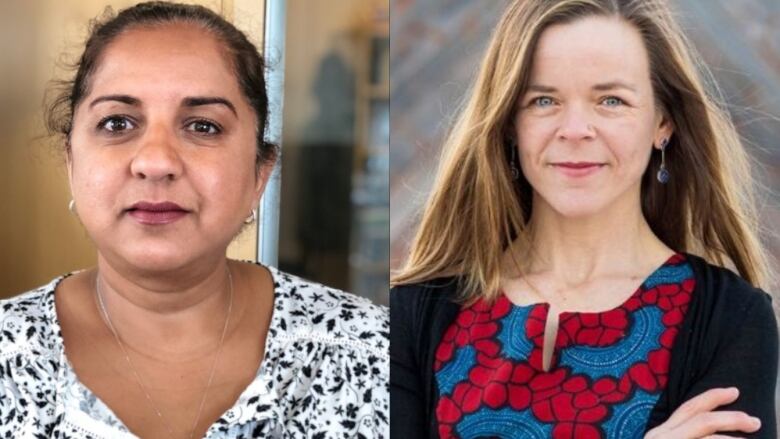False negative tests to coming home at Christmas: N.W.T. top doctors answer your COVID-19 questions
Chief Public Health Officer Dr. Kami Kandola along with Dr. Sarah Cook took your questions live

From out-of-territory travellers coming home forChristmas holidays to false negative tests, the territory's top doctors took people's latest questions about COVID-19 in the Northwest Territories on Thursday.
The N.W.T.'s Chief Public Health Officer Dr. Kami Kandola and territorial medical director Dr. Sarah Cook answered the questions live on CBC's The Trailbreaker.
Since CBC'slast call-in show with health experts in September, the territory reported its first confirmed cases of COVID-19 in months.
On Oct. 16, three people had received presumptive positive COVID-19 test results. This week all three cases, one from Inuvik, N.W.T., and two from Yellowknife were confirmed. Health officials warned of two places in the capital that carry risk of potential exposure.
There was also one presumptive positive case reported at the Gahcho Ku Diamond Mine on Wednesday, but the territory later said it was a false positive test.
As of Wednesday,there hadbeen 6,000 COVID-19 tests completed in the N.W.T. and 20 results were pending. There have been eight confirmed cases of COVID-19 in the territory, and five ofthose peoplerecovered months ago.
South of the territorial border, Alberta broke its single-day record for COVID-19 cases on Wednesday, reporting 406 cases, as well as three deaths. The province also hit a record in active cases, with 3,372.
Here are some of the questions put to Kandola and Cook on Thursday morning:
Can rapid testing be used during Christmas holidays or is there a plan to manage the increased travel during that time?
Generally,testing is not a substitute for isolation.
Cook says that testing people without symptoms has an even higher rate of false negatives.
"What that means is that if someone is coming in from out of territory or in an area of high prevalence of COVID, just because they have a negative does not mean that they don't have COVID and don't have a risk. So it doesn't change the need for self isolation," Cook said.
"A student coming in needs to be in self isolation for those 14 days, even if they had a test that was negative."
Kandola says people need to remember thatcases are continuing to rise across the country.
"When these students and people are returning or people are coming up at Christmas, if our infection rate continues to go at the rate it is, we're going to be dealing with more imported cases coming back in that we have to quickly detect and isolate," Kandola said.
Will N.W.T. be joining Canada's COVID-19 contact tracing app?
The federal government administered a smartphone app that allows users to report a positive coronavirus test and alert others of a potential exposure.
Kandola says the territory is undergoing a privacy impact assessment on it. As well, she says in the N.W.T., it wouldn't beas usefulas it is in other jurisdictions since the cases are all related to travel and not community-spread.
"If people are travelling out it could be of strong use," she said.
"One of the issues that we are grappling with is the number of false alarms. So you could get an alert and say that you were potentially exposed to a COVID case," Kandola explained.
She says the territory is trying to avoid having people in isolation who might not have had contact with a COVID-19 case, since itcould cause"economic and societal disruption."
Why did the mine worker get a false positive?
Cook says false positives are quite rare, particularly when using the testing device in Yellowknife's Stanton Territorial Hospital.
The initial false positive test from the Gahcho Ku mine was run on a device the territory has no jurisdiction over, Cook said.
Many things can cause a false positive including the swab and the quality of the sample, she added.
What needs more attention are false negative tests, Cook says, which can occurabout in 25 positive cases out of 100.
"If someone has symptoms and they've had contact and they do a test and it's negative and they still are sick, they need to still be self isolated and test again," she said. "So this is really important to remember because these tests are just not perfect."
How should rumours of people not following the health guidelines be dealt with?
Kandola says there's a formal investigation process in place to look into allegations of people not following the isolation protocol. Often, Kandola says the allegations are rumours. Complaints that are legitimateare investigated and followed up in "due process."
She added that's the "best way" to deal with concerns rather than posting to social media about it, which causes stigma.
"My concern is people minimizing symptoms and completing the 14 days of isolation, but still being infectious because they are too afraid of what the public would do if they were to go to get tested," she said.
"So you have to be very measured by the formal process to make it safe for people to want to get tested."












_(720p).jpg)


 OFFICIAL HD MUSIC VIDEO.jpg)
.jpg)



























































































